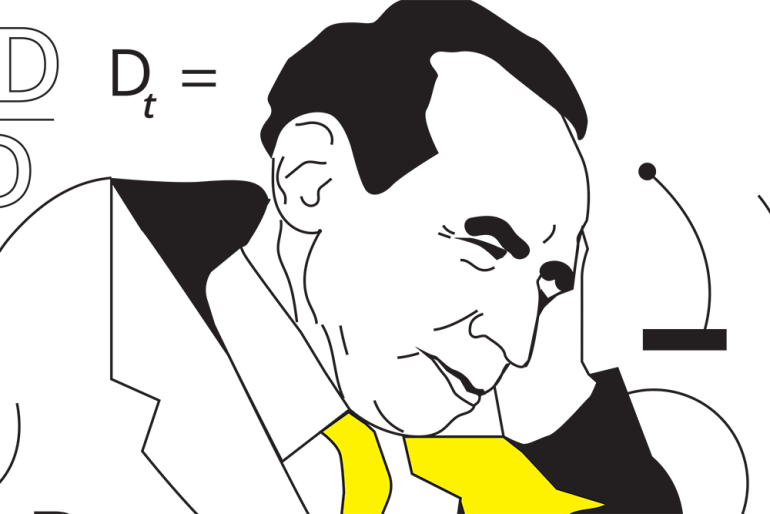
Just over half a century ago (on 17 April 1970), a distinguished economist, Michał Kalecki died in Warsaw. In the 1930s and 40s, he achieved international renown as a co-founder of what came to be known as the Keynesian Revolution, before passing into the company of “interesting” but neglected thinkers, both for an older generation of mainstream economists and the pantheon of Post-Keynesian and heterodox economists, the latter searching for a more contemporary criticism of capitalism than that provided by Karl Marx and a sharper criticism than that provided by Keynes. The comparison with the two critics is illuminating, even if, in a relatively brief article like this one, it is impossible to do full justice to the ideas of any of them.
EARLY YEARS
Michał Kalecki was born on 22 June 1899 in Łódź into a Jewish family which had assimilated into Polish culture and the Polish language serving as a common language in a city mixing Russians, Poles, Germans, Austrians and Jews. His father, Abram Kalecki, owned a small spinning mill, which afforded him a life of modest comfort, supporting an elegant wife, Klara and then their son.
However, the outbreak of revolution in the Russian empire in 1905 shattered their comfort. As the largest industrial centre of the empire, Łódź was thrown into chaos with riots, street fighting, assassinations and factory occupations by workers, made only worse by the brutal attempts of authorities to suppress the revolt. Despite the imposition of martial law in 1905, at the request of the larger factory owners, social unrest continued right up to the outbreak of World War I. The socialists were not the only source of trouble. Polish nationalists targeted Jewish businesses and socialist leaders for attack. In 1910, Klara Kalecka left her unlucky family. Three years later, in 1913, Abram Kalecki shut down his factory.
The young Kalecki completed his school education in an atmosphere of insecurity, insurrectionary chaos and, from 1915, German occupation that reduced the city to poverty. He went on to study engineering in Warsaw and then Gdańsk, with a brief period of military service in between. However, without financial support he was forced to abandon his studies. He returned to Łódź, where he supported himself and his father with business and financial journalism, becoming an expert on the international corporations that dominated manufacturing and mining in Poland. This led to his first proper job, in the research Institute for the Study of Business Cycles and Prices (Instytut Badań Koniunktur Gospodarczych i Cen) established in Warsaw in 1928 by the Polish Ministry of Trade and Industry. Kalecki was the Institute specialist on business cartels. The post enabled him to marry Ada Szternfeld, who was also from Łódź.
The work in Warsaw also introduced him to a more academically accomplished Oskar Lange and his Union of Independent Socialist Youth (Związek Niezależnej Młodzieży Socjalistycznej). Lange, a Marxist, had his doctorate in economics from the ancient university in Kraków. He had been expelled from the Polish Socialist Party for being too left-wing. The Union of Independent Socialist Youth was thus independent of the older established Polish Socialist Party. But it was also too critical of developments in the neighbouring Soviet Union to be aligned to the Polish Communist Party. Many of Kalecki’s first economic analyses appeared in the Union’s monthly Socialist Review (Przegląd Socjalistyczny) until it was shut down by the authorities at the end of 1932.
In the following year, the Institute published Kalecki’s Essay on the Business Cycle Theory aiming to show how market forces bring capitalist economies not to any kind of equilibrium, with all resources fully utilised, but make those economies move naturally between booms and slumps. Arguably, the essay contains in summary the essential ideas of Kalecki’s economics, even if he would modify their mathematical formulations in years to come.
After Piłsudski’s coup in 1926. The economic situation in Poland deteriorated, in the wake of the 1929 crash (Poland experienced the biggest fall in national income among all European countries at that time), and the military government became more and more repressive, emulating the bombastic nationalism and xenophobia of the Italian Fascists. In 1935, unable to get a permanent university position, Oskar Lange got out and went to the United States on a Rockefeller Fellowship. In 1936, Kalecki’s turn came. He went first to Sweden and then to London, where Keynes had just published his General Theory of Employment, Interest and Money. The coincidence between their ideas was striking. But their respective political economies differed. This paradox is explored in the rest of this article.
KALECKI MEETS KEYNES
To understand the intellectual coincidence between the two economists; indeed, to understand the nature of what is called the Keynesian Revolution, it is necessary to define what that revolution was. The most common interpretation among economists and non-economists, uniting post-Keynesians, with more mainstream Keynesians, Keynes’s followers, such as Joan Robinson, Nicholas Kaldor and theorists of the post-1940s neo-classical synthesis, such as Paul Samuelson, Oskar Lange and John Hicks, is the notion that, in the capitalist market economy, production and employment are constrained by aggregate demand. The revolution effectively discredited the “neo-classical” idea prevailing from the 1870s according to which full employment would be assured with price and wage flexibility.
But the idea claiming that output and employment are limited by market demand was not new in the time of Keynes and Kalecki. It was already well known before the 1930s, and not just in the “underworld of underconsumptionists”, such as Jean Charles de Sismondi, Karl Marx, Thorstein Veblen and John A. Hobson, but also among widely respected theorists of the monetary business cycle, such as Ralph Hawtrey, whose 1913 book Good and Bad Trade contains the first use and definition of the term “effective demand” (“A want becomes an effective demand when the person who experiences the want possesses (and can spare) the purchasing power necessary to meet the price of the thing that will satisfy it.”)
Another definition of the Keynesian Revolution that later took hold, following Keynesians such as George Shackle, was the idea that, at the core of Keynes’s Revolution was the introduction of uncertainty and expectations into the process of economic decision-making. The notion that people hold money because they are uncertain about the future became a staple of post-Keynesian monetary theory. This is certainly an idea which Keynes employed in an original way in the monetary analysis in the General Theory. But uncertainty and expectations had been widely discussed among leading economists well before Keynes added his monetary and philosophical reflections. In the United States, uncertainty and expectations as the foundations of institutions and decisions were well known from the work of Veblen and Frank Knight. In Europe, Friedrich von Hayek, whose political economy shared nothing with Keynes and Kalecki, made uncertainty a cornerstone of Austrian accounts of market process and entrepreneurship. Marxists too had long contrasted the “chaos” of market capitalism with the certainty provided by economic planning.
There is a related a definition that highlights Keynes’s recognition that modern market economies lack the kind of market coordination provided by a Walrasian “auctioneer” to ensure that trade only occurs at equilibrium prices. This somewhat more refined version of the “market chaos” idea made something of a come-back among “New Keynesian” economists, emphasising the problems of information in decentralised decision-making. However, it had been explored, for example, by Swedish economists before Keynes presented his distinctive critique of decentralised economic decision-making, weakening Keynes’s claims to its discovery.
The fundamental intellectual innovation Kalecki and Keynes shared was something different. It was the realisation that, in a capitalist economy, with only capitalists and workers, where production is undertaken for profit, output and employment are determined by the level of investment. Kalecki’s explanation for this (and Keynes’s, but not in his General Theory) was disarmingly simple. If capitalists sell their goods to earn a profit, then the most that they, altogether as capitalists, can recover by selling to their workers is the total value of what capitalists have paid them in wages. To obtain a profit over their wage costs, capitalists have to sell to someone else, not their workers. This can only be the capitalists themselves, buying equipment for investment or luxury goods for their own consumption.
This definition of Keynes’s and Kalecki’s fundamental innovation is important because it puts their work in a much clearer contrast with the macroeconomic theory of their time. In the neo-classical version of macroeconomics, total output and employment is determined by the total amount of available factors of production. Within this, actual employment is supposed to be determined, in inverse proportion, by the real wage rate which determines business demand for labour. Kalecki’s demolition of this view, arguing that wage changes have complex effects on output and employment that overall largely cancel each other out, was accorded high praise by Keynes.
The alternative to the neo-classical view was the underconsumptionist view, going back to the Ricardian socialists of the mid-nineteenth century. They argued that poverty and unemployment exist because workers do not receive the full value of their labour. A later critic of the neo-classical view, J.A. Hobson, linked this to the unequal distribution of income, arguing that people with higher incomes save too much. Low real wages mean that consumption is inadequate to secure full employment (the view of Veblen and the followers of Marx). In this way, the underconsumptionists were the original proponents of the idea that effective demand constrains aggregate output and employment.
Both Keynes and Kalecki deplored low wages for moral and social reasons because low wages and unemployment were unjust outcomes of free market capitalism, rather than because low wages cause unemployment. And the wage share is a misleading policy tool in an economy that produces for profit rather than to raise wages. Kalecki was adamant that investment determines output and employment because, stripped to its essentials, the money spent on investment accrues through the market process to capitalists as profits, and those profits motivate production and employment.
THE POLITICAL ECONOMY OF KALECKI AND KEYNES
By thinking through the income and expenditure flows in a capitalist economy, Kalecki and Keynes independently worked out the key factor that determines the level of employment in an economy. They also shared a joint commitment to full employment, a commitment that was common enough after the seemingly intractable mass unemployment of the Great Depression of the 1930s: the only difference between economists at the time on this matter was whether the unemployed would find work if wages fell sufficiently low (the neo-classical position opposed by Keynes and Kalecki); or whether unemployment could be resolved by raising wages (the underconsumptionist view); or whether it could be achieved by government expenditure (the position of Keynes and Kalecki).
After World War II, the association of Keynes’s name with a general doctrine of aggregate demand management stuck, and indeed the postwar decades came to be known as the Keynesian era. In truth, government policies at the time bore only a superficial resemblance to the actual policies that Keynes advocated. Keynes argued for permanently low interest rates (his “euthanasia of the rentier”) and higher taxes on the rich. But a fiscal stimulus was to be restricted to periods of economic recession, and he was cautious about supporting the comprehensive welfare programme put forward by William Beveridge, which Keynes thought would burden the taxpayer excessively. A fiscal stimulus, Keynes thought, should be conducted by public works, rather than the expansion of welfare and public services, and nationalisation was an irrelevance. Keynes believed that in this way it is possible to secure full employment without changing capitalism. Fiscal policies in post-war Europe and North America embraced aggregate demand management, which has loosely been referred to as “Keynesian”. But comprehensive social insurance and government control of leading sectors of the economy were much closer to the ideas of Hobson, who had argued for social welfare, redistributive fiscal policies, and government management of the economy even before World War I.
Kalecki’s political economy was far more radical. Keynes sometimes wrote as if we could have full employment in capitalism, once everyone came to their senses and realised how right Keynes was. Kalecki knew that full employment would be contested by capitalists because it threatened their “power in society”. Full employment would remove the threat of unemployment that employers hold over their workers to keep them subservient. The working class would “acquire confidence”. In this way, full employment (rather than economic crisis) would be the transition to socialism.
Along the way, there would of course be distributional problems, if workers in certain industries pushed for higher wages than elsewhere. But these were political rather than economic difficulties. Capitalists may respond to the loss of their power with an “investment strike”. They might talk about it. But Kalecki doubted that businessmen would forego profitable opportunities for investment in order to make a political point. As he later observed, “capitalists do many things as a class, but they certainly do not invest as a class” because they are motivated in their investments by the profits of their firm, rather than the profits of their class.
Keynes’s death in 1946 did not only facilitate the misinterpretation of his economics and political economy, it also meant that he was not around to comment critically on the policies to which his name was attached. Kalecki, however, lived for almost a quarter of a century longer: from 1945 to 1955, working at the International Labour Organisation, and then in the United Nations in Montreal and New York, and then back in Warsaw at the Polish Planning Commission and doing research and teaching. He did not lose faith in the cardinal principle of political economy contained in the Keynesian Revolution, namely the ability of the state to secure full employment through fiscal policy. But he was much more critical of how this was achieved, if at all, in the capitalist countries.
Kalecki identified the roots of German and Japanese industrial success with their military defeat in World War II. The ban on heavy armaments production in those countries, imposed by the victorious powers, was followed by rearmament, which obliged the governments of the defeated powers to buy their military equipment from the United States and Britain. In exchange, Germany and Japan won access to those markets for their industrial exports. The resulting arrangement handed industrial superiority to Germany and Japan, whose capitalists had no alternative but to invest in industry with civilian uses, and directed US and British capitalists to armaments production that depended on political decisions on war or the threat of war, rather than civilian production with more dynamic and socially useful markets.
FINAL YEARS
In the final decade of his life, Kalecki gradually fell out with the political authorities in Poland. The purpose of socialism, he thought, was to improve the lives of working people and he was unforgiving of socialist governments that failed to secure that improvement. The usual reason behind this failure was the pursuit of some political goals, whether military superiority or industrialisation, which promised future triumph and diverted resources from the supply of wage goods for workers today. As “meat crises” (shortages of basic consumer goods) became endemic in Communist Poland, Kalecki’s criticism of visionary planning aroused the hostility of the political leadership. The political response was primitive. After the defeat of Poland’s Arab allies by Israel in the Six Day War in 1967, Jews were purged from the Polish government, universities and the professions. In addition, Kalecki and other critics were condemned for “revisionism” and “sowing confusion in political economy”. Kalecki’s followers were expelled from the ruling party (many of them, as sincere socialists, had been its members), fired from their jobs, and forced into exile.
Kalecki was horrified, and not just by the recurrence of the ancient social pathology of antisemitism. At times, he even speculated whether the US government was not behind the effort to crush the modern research and teaching in political economy that he had built up in Warsaw. But after a two-month stay with old friends at Cambridge in the UK, he returned to Poland, where he died on 17 April 1970.

JAN TOPOROWSKI – Professor of Economics and Finance at the SOAS University of London. His research concentrates on monetary theory and policy, finance, and the work of Michał Kalecki. He is the author of Michał Kalecki: An Intellectual Biography. Volume I: Rendezvous in Cambridge 1899-1939 (Basingstoke: Palgrave 2013), Michał Kalecki: An Intellectual Biography. Volume II: By Intellect Alone 1939-1970 (Basingstoke: Palgrave 2018) (Polish edition: Michał Kalecki. Biografia intelektualna, translated by Aleksandra Paszkowska, Warszawa: Krytyka Polityczna 2022) and Interest and Capital the Monetary Economics of Michał Kalecki (Oxford: Oxford University Press 2022).



